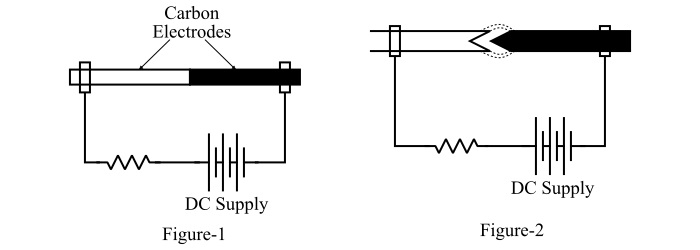
 Data Structure
Data Structure Networking
Networking RDBMS
RDBMS Operating System
Operating System Java
Java MS Excel
MS Excel iOS
iOS HTML
HTML CSS
CSS Android
Android Python
Python C Programming
C Programming C++
C++ C#
C# MongoDB
MongoDB MySQL
MySQL Javascript
Javascript PHP
PHP
- Selected Reading
- UPSC IAS Exams Notes
- Developer's Best Practices
- Questions and Answers
- Effective Resume Writing
- HR Interview Questions
- Computer Glossary
- Who is Who
Types of Arc Lamps | Carbon Arc Lamp, Flame Arc Lamp, Magnetic Arc Lamp
A type of electric lamp that produces light by creating an electric arc in the gap between two electrodes when the electric supply is connected to these electrodes is known as arc lamp.
Types of Arc Lamps
Arc lamps are classified into following four types, viz −
DC Carbon Arc Lamp
AC Carbon Arc Lamp
Flame Arc Lamp
Magnetic Arc Lamp
DC Carbon Arc Lamp
The construction of the DC carbon arc lamp is shown in Figure-1.

In this types of carbon arc lamp, two carbon electrodes are used. These two electrodes are placed touching to each other face to face and a DC supply of voltage of 40 to 60 V is applied. When electric current flows through the electrodes, they soon become incandescence due to high resistance of carbon.
Now, if the electrodes are slightly separated, so that a gap of about 2 mm to 3 mm is formed between the electrodes. Consequently, an arc is created between the electrodes in the gap and a white light is produced.
In this type of arc lamp, the transfer of carbon particles from one electrode to the other electrode maintains the arc in the gap. Because of the transfer of carbon particles, the positive electrode after some time becomes hollow and the negative electrode becomes as a pointed pencil as shown in Figure-2.
Both the electrodes of the DC carbon arc lamp burn out after some time. The rate of burning of positive electrode is twice that of the negative electrode. Therefore, the area of cross-section of the positive electrode is made twice of the area of negative electrode.
AC Carbon Arc Lamp
The construction and working of the AC carbon arc lamps be same as that of the DC carbon arc lamps.
In case of AC carbon arc lamp, the burning of both the positive and negative electrodes is same. Therefore, their area of cross-section is same. Since, the carbon of the electrodes is consumed during the operation of the lamp, hence frequent adjustment for the gap between the electrodes is required.
In case of large AC carbon arc lamps, an automatic device is provided for feeding the carbon into the arc.
The AC carbon arc lamps require AC voltage of about 40 volts for their operation, where the arc length is in mm. The overall luminous efficiency of a typical AC carbon arc lamp is very low, about 12 lumens/watt. In AC carbon arc lamps, a series inductor is used for stability of the arc.
For an AC carbon arc lamp, the temperature of positive carbon electrode is about 3500 °C to 4000 °C and the temperature of the negative carbon electrode is about 2500 °C. Therefore, the percentage of production of light from an AC carbon arc lamp would be as follows −
85% of light is produced by the positive carbon electrode.
10% of light is produced by the negative carbon electrode.
5% of light is produced by the air.
Flame Arc Lamp
The flame arc lamps also operate on the same working principle on which the carbon arc lamps do. The construction of the flame type arc lamp is shown in Figure-3

The electrode of a flame arc lamp has 5% to 15% fluoride (called the flame material) and 85% to 95% carbon. The fluoride has a characteristic that is, it radiates light energy efficiently from a very highly heated arc stream. The fluoride turns into vapor along with the carbon and these vapors generate a very high luminous intensity. The luminous efficiency of flame arc lamps is about 8 lumens per watt.
Magnetic Arc Lamp
The basic construction and working of the magnetic arc lamp remains the same as that of the carbon arc lamp. The only difference is that, in case of magnetic arc lamp, the positive electrode is made of copper and the negative electrode is of magnetic oxide of iron.

